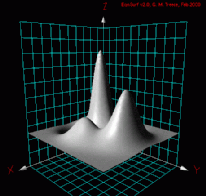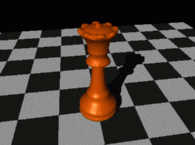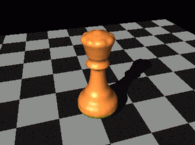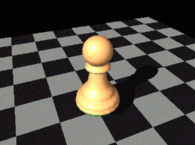
Difference: GMTSoftware (1 vs. 22)
Revision 22
14 Dec 2023 - gmt11
| Line: 1 to 1 | ||||||||
|---|---|---|---|---|---|---|---|---|
| ||||||||
| Line: 26 to 26 | ||||||||
| ||||||||
Revision 21
09 Sep 2021 - gmt11
| Line: 1 to 1 | ||||||||
|---|---|---|---|---|---|---|---|---|
| ||||||||
| Line: 12 to 12 | ||||||||
| ||||||||
| Changed: | ||||||||
| < < |
| |||||||
| > > |
| |||||||
Revision 20
11 Sep 2020 - gmt11
| Line: 1 to 1 | |||||||||
|---|---|---|---|---|---|---|---|---|---|
| |||||||||
| Line: 8 to 8 | |||||||||
Much of the research described in these pages has been implemented in software, and the binary executables are freely available for anyone to use for their own research or enjoyment. If you do use any of them for your own research, please let me know, and cite the appropriate paper. Also, I would welcome any feedback on the usefulness or otherwise of these packages - please tell me what you think! The various programs and utilities are:
Research-based | |||||||||
| Changed: | |||||||||
| < < |
| ||||||||
| > > |
| ||||||||
Teaching-based
| |||||||||
| Changed: | |||||||||
| < < |
| ||||||||
| > > |
| ||||||||
| Deleted: | |||||||||
| < < |
StradviewStradview is a user-friendly medical 3D data visualisation package which can run under Windows, and implements many of the algorithms described in the research page. It was originally developed from Stradwin, but without any of the live ultrasound acquisition features, which makes it much more appropriate for those who only need to visualise and analyse existing medical data.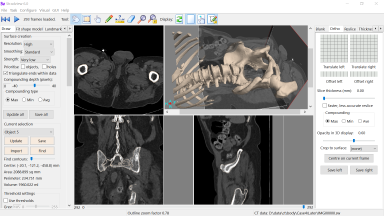 For more information, and to obtain the software, see the Stradview page.
For more information, and to obtain the software, see the Stradview page.
StradwinStradwin was originally developed for freehand 3D ultrasound, but also incorporates many other techniques for visualising and analysing medical data. It has been developed with the aim of encouraging clinical research in this area. Those who are only interested in visualisation and analysis of data should use Stradview instead.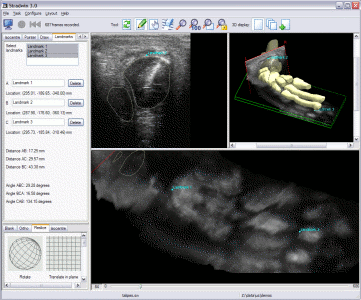 This is available free - see the stradwin documentation page for much more information about availability and technical content.
This is available free - see the stradwin documentation page for much more information about availability and technical content.
wxDicom wxDicom was originally written as a simple tool to demonstrate various image interpolation and filtering techniques in a teaching setting. It has since been expanded to allow it to load medical data from various sources (including DICOM) in addition to several standard image formats. Since it can also save sequences of images, it can be used to load, process, then save DICOM data to a standard image sequence. It also implements the Bitonic filter and Refined Metal Artefact Reduction for CT data. For more information, and to obtain the software, see the wxDicom page.
wxDicom was originally written as a simple tool to demonstrate various image interpolation and filtering techniques in a teaching setting. It has since been expanded to allow it to load medical data from various sources (including DICOM) in addition to several standard image formats. Since it can also save sequences of images, it can be used to load, process, then save DICOM data to a standard image sequence. It also implements the Bitonic filter and Refined Metal Artefact Reduction for CT data. For more information, and to obtain the software, see the wxDicom page.
Structurally Varying Bitonic filter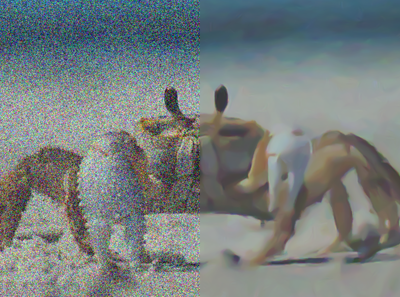 This is a filter combining robust structurally varying (adaptive) morphological operations and an adaptive anisotropic Gaussian, with high noise reduction performance, particularly for very high noise levels. It is founded on preserving signal bitonicity, and since this concept only involves the order of values, not the image levels, it is naturally edge-preserving.
This is a filter combining robust structurally varying (adaptive) morphological operations and an adaptive anisotropic Gaussian, with high noise reduction performance, particularly for very high noise levels. It is founded on preserving signal bitonicity, and since this concept only involves the order of values, not the image levels, it is naturally edge-preserving.
Bitonic filter This is a filter for removing noise in signals and images whilst preserving edges and other bitonic data, ie. anything with either one local maximum or minimum within the range of the filter. It has better edge-preserving properties than a median filter, whilst also removing noise similarly to a Gaussian filter. It has wide applicability and very few parameters, with no need for training or prior knowledge of the noise variance, and is hence particularly suited to situations where the noise is varying.
This is a filter for removing noise in signals and images whilst preserving edges and other bitonic data, ie. anything with either one local maximum or minimum within the range of the filter. It has better edge-preserving properties than a median filter, whilst also removing noise similarly to a Gaussian filter. It has wide applicability and very few parameters, with no need for training or prior knowledge of the noise variance, and is hence particularly suited to situations where the noise is varying.
IsoSurfThis can be used for extracting triangulated iso-surfaces from a block of data - for instance the skin and skeleton which have been extracted from the female cadaver of the Visible Human Project data set, shown below. This is an image of a full 3-D model.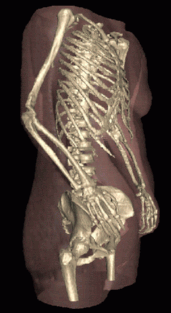 The software implements Regularised Marching Tetrahedra to triangulate the iso-surface, and Maximal Disc Guided Shape Based Interpolation to interpolate the thresholded data if required. The input is from a regular block of data, which can be scaled differently in each direction, and the surface can be extracted at any resolution. The output is a surface triangulation and a set of cross-sectional contours. For more information, and to obtain the software, see the IsoSurf page.
The software implements Regularised Marching Tetrahedra to triangulate the iso-surface, and Maximal Disc Guided Shape Based Interpolation to interpolate the thresholded data if required. The input is from a regular block of data, which can be scaled differently in each direction, and the surface can be extracted at any resolution. The output is a surface triangulation and a set of cross-sectional contours. For more information, and to obtain the software, see the IsoSurf page.
EqnSurfThis can be used for generating triangulated surfaces from implicit functions, for instance those shown below.
VolMorphThis uses the same algorithm as used in IsoSurf for interpolating cross-sections to surfaces, but this time applied to the interpolation of surfaces to form time sequences. This means it can be used to 'morph' one surface into another, for example the queen and pawn shown below, which was generated in less than two minutes from the original objects (click the middle image to see a low quality movie of this morph sequence):
| ||||||||
